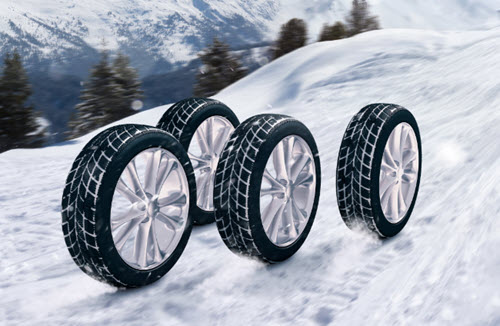|
Getting a Grip: All-Season Vs. Winter Tires
Having the right tires on your vehicle is crucial for safe driving, and at no other time are the right tires more important than during winter. Is it good enough to keep your all-seasons on during winter, or should you be switching to winter tires?
The truth is that, in Canada, all-season tires are just not up for the job. The cold, snowy, and wet conditions that drivers face from coast to coast require tires that are specially made to deal with such conditions.

All-Season Tires: Truly for All Seasons?
All-season tires offer perfectly good performance during the warmer months of the year. From when it begins to warm up in the springtime to when it starts to cool down in the fall, all-season tires can help you safely navigate a variety of roads and road conditions.
The main issue with all-season tires is that their performance sharply declines once temperatures dip below 7°C. Once it falls below 7°C, the rubber in all-season tires becomes much more rigid. Driving with a rigid tire means driving with far less traction, as the tire can no longer grip the road very well. All-season tires are much better thought of as warmer-season tires.
Winter Tires for Winter Weather
Just as you start wearing your specially designed and extra-grip boots when the temperatures drop and the ground becomes slippery, so should you be putting winter tires on your vehicle. Winter tires can do a much better job of keeping you safe because they are designed with winter driving conditions in mind. They can be identified by the symbol of a snowflake inside of a mountain.
Winter tires are unique because they remain flexible even when temperatures reach below 7°C due to being made of a softer rubber compound. This increased flexibility means increased traction on the road. A softer and more malleable tire is able to splay out and get a better grip on snow, ice, and pavement.
The increase in traction, in turn, translates to reduced braking distance, especially in slippery conditions. Vehicles equipped with winter tires are 40% less likely to be involved in a collision than are vehicles equipped with all-seasons. Winter tires and the traction they provide can enhance other Honda vehicle features, such as traction control, vehicle stability assist, all-wheel drive, and anti-lock braking systems.
When compared to all-season tires, winter tires are also less likely to hydroplane. Hydroplaning occurs when a thin sheet of water lies between a tire and the pavement. Winter tires have special groves which are designed to siphon water out from under the tires and direct it away. They are also narrower in design than other tires, which allows them to keep better contact with the pavement by essentially “slicing” through any slow, water, or slush which may be in the way.
Winter Tire Use and Maintenance
The only way to ensure that you get all of the above-mentioned benefits of winter tires is to use them right. For starters, you should always install a complete set of four winter tires, instead of mixing different types together. As you would with any model of tire, take the time to check air pressure at least once a month. Before the start of every winter season, you should also check to see if the tread has worn down below the indicator markings. If yes, then it’s time for a new set.
Switching to winter tires once the temperatures dip below 7°C should be thought of as a necessity, not a suggestion. They are an important tool for enhancing safety for yourself and your passengers while you drive.
And remember now is the perfect time to shop for a new set of winter tires or book your winter tire swap appointment, before the rush and to ensure you’re ready when the cold and snow hit.

|